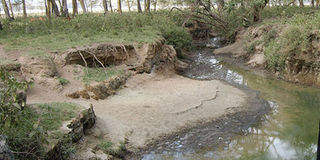In the muteness of the caves of Njoro, life meets expectant life

River Njoro. This river harbours more than just life; for many pilgrims, it is also the Kenyan answer to River Jordan in the Middle East. PHOTO | JOSEPH KIHERI | NATION MEDIA GROUP
What you need to know:
- Local folklore indicates that the site was discovered about 50 years ago by a man known only as Waiganjo who, while on a mission to find a cure for a disease that ailed him, found God instead.
- However, long before Waiganjo made these caves a pilgrimage site, warriors in the freedom struggle are said to have found them warm and safe enough to hide in.
River Njoro is famous for a lot of things.
For one, it is the lifeline of the communities that have settled along its banks, while for archaeologists' it is a rich repository of culture and traces of medieval human enterprise.
But this river harbours more than just life; for many pilgrims, it is also the Kenyan answer to River Jordan in the Middle East.
To understand its influence on Christian faith, make your way to a small village called Njokerio, off the Nakuru-Narok road, and ask to see the Holy Caves of Njoro.
There isn’t much in the form of infrastructural development here, so you will have to snake your way down a narrow path that leads to the banks of the river, and onwards to a clearing that the locals call ‘Nyumba ya Mungu’ (House of God).
It is that clearing that has become a revered pilgrimage site for a lot of Christians, who see it as the ideal place for prayer and meditation.
And, as if to reassure you that you have hit the bull’s eye, a huge signboard informs you that you are standing on a “sacred place”.
Nearby, three caves barricaded with wooden gates add to the cosy feeling of standing on holy ground, while above them a miniature waterfall sprinkles misty water to the tens of pilgrims gathered at the site.
Local folklore indicates that the site was discovered about 50 years ago by a man known only as Waiganjo who, while on a mission to find a cure for a disease that ailed him, found God instead.
GREAT SITE
He ended up fasting and praying for 60 days, the story goes.
After he left — to begin a new life as an evangelist — he announced to his followers that his place of rebirth was godly, and that they should gather there once in a while to reconnect with the supernatural.
However, long before Waiganjo made these caves a pilgrimage site, warriors in the freedom struggle are said to have found them warm and safe enough to hide in.
The parallels between religion and society are hard to miss, but what matters to the modern tourist visiting the site today are not the motivations of those who came here before them, but the intoxicating feeling that one gets when one stands on hallowed grounds.
The site, however, is not just a pilgrimage site, but also a nature lovers’ paradise.
Here, where time seems to have stood still and birds are at their most soulful and colourful, water meets rock, and rock meets soil, and soil meets, roots, and roots meet trunks, which then branch out to form canopies that, in their evergreen wonder, breathe life into life itself.




